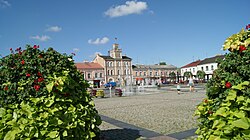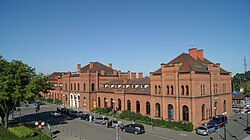Skierniewice
Certain historical revisions of this page may meet criterion RD1 for revision deletion, as they contain significant copyright violations of https://www.spangshus.dk/poland/skierniewice (Copyvios report) and of https://www.britannica.com/place/Skierniewice (Copyvios report) that have been removed in the meantime.
Note to admins: In case of doubt, remove this template and post a message asking for review at WT:CP. With this script, go to the history with auto-selected revisions. Note to the requestor: Make sure the page has already been reverted to a non-infringing revision or that infringing text has been removed or replaced before submitting this request. This template is reserved for obvious cases only, for other cases refer to Wikipedia:Copyright problems. Note to others: Please do not remove this template until an administrator has reviewed it. |
Skierniewice | |
|---|---|
Rynek (Market Square), and Skierniewice railway station | |
| Coordinates: 51°57′10″N 20°8′30″E / 51.95278°N 20.14167°E | |
| Country | |
| Voivodeship | Łódź |
| Powiat | City county |
| Gmina | Skierniewice |
| Established | before 1217 |
| City rights | 1457 |
| Government | |
| • City mayor | Krzysztof Jażdżyk |
| Area | |
| • Total | 3,503 km2 (1,353 sq mi) |
| Population (31 December 2021) | |
| • Total | 47,031 |
| Time zone | UTC+1 (CET) |
| • Summer (DST) | UTC+2 (CEST) |
| Postal code | 96-100 |
| Area code | +48 46 |
| Car plates | ES,ESK |
| Website | http://www.skierniewice.net.pl |
Skierniewice [skʲɛrɲɛˈvʲit͡sɛ] is a city in central Poland with 47,031 inhabitants (2021),[1] situated in the Łódź Voivodeship. It is the capital of Skierniewice County. The town is situated almost exactly halfway between Łódź and Warsaw. Through the town runs the small river Łupia, also called Skierniewka.
History[edit]

The oldest known mention of Skierniewice comes from 1359, although it had existed earlier.[2] A palace of the archbishops of Gniezno already existed in the village at that time.[2] Skierniewice gained municipal rights in 1457 and was vested with various privileges in 1456–1458.[2] Administratively it was part of the Rawa Voivodeship of the Greater Poland Province until the Partitions of Poland. Skierniewice was located on a trade route connecting major Polish cities Toruń and Lwów.[2] Local merchants also participated in trade with Gdańsk, Lesser Poland and Podolia, as well as German states.[2] One yearly fair took place since 1457, in 1527 King Sigismund I the Old established a second fair, and in 1641 the Sejm established two more fairs.[2] The town suffered in the 18th-century as a result of the Swedish invasion of Poland and epidemics, and in 1793 it was annexed by Prussia in the Second Partition of Poland.[2]

Regained by Poles as part of the short-lived Duchy of Warsaw in 1806, in 1815 it became part of so-called Congress Poland and fell to the Russian Partition.[2] In 1845 the Warsaw-Vienna Railway was opened, which passed through Skierniewice. Subjected to Anti-Polish and Russification policies, many inhabitants took part in the unsuccessful Polish January Uprising in 1863 and in 1905–1906 Polish protests took place in the town.[2] On September 15, 1884 it was the setting for the meeting of the Three Emperors' League.
During World War I it was occupied by Germany, and after the war, in 1918, it became part of the re-established Polish state.
During the invasion of Poland, which marked the beginning of World War II, in September 1939, the Germans raided the town, bombing the railway station, as well as houses, the hospital and a church during a church service.[3] Around 150 people were killed, and another 200 were wounded, 100 buildings were destroyed.[3] Captured by the Wehrmacht on September 10, 1939,[3] the next day German troops carried out an execution of 60 Poles in the town (see Nazi crimes against the Polish nation).[4] On September 11–12, Adolf Hitler visited the town.[2] During the occupation, the Germans established a transit camp for Polish prisoners of war, later deported to Nazi Germany, and a ghetto for Jews, later deported to the Warsaw Ghetto and Nazi concentration camps.[2] The Germans executed over 200 people in the town, however, the Polish underground resistance movement still operated there.[2] Resistance activities included sabotage actions, secret Polish education and the assassination of a German V-2 rocket expert.[2] In 1941, expelled Poles from Kwiatkowo and Linne, were deported to Skierniewice.[5] In May 1944, the Stalag 319 prisoner-of-war camp for Allied POWs of various nationalities was relocated from Chełm to Skierniewice, and then eventually dissolved in August 1944.[6] Afterwards the Dulag 142 transit camp was based in the city, and about 3,000 Poles captured during the Warsaw Uprising passed through it.[7] On January 17, 1945, Skierniewice was captured by Soviet forces.
Sights[edit]
Among the historic sights of Skierniewice are:
- former Episcopal Palace complex with the Park Miejski ("Municipal Park")
- Skierniewice railway station
- churches of Saint James and Saint Stanislaus
- Market Square (Rynek) with the Town Hall (Ratusz)
- Roundhouse Skierniewice
- other historic buildings and structures, including the Kozłowski Villa, now housing the Wedding Palace, and the County Office
-
Episcopal Palace
-
Kitchen building of the Episcopal Palace complex
-
Park Miejski
-
One of the streets of the town centre with historic townhouses and the Saint James church
-
County office
Education[edit]
Sports[edit]
Unia Skierniewice and Widok Skierniewice football clubs are based in Skierniewice.
International relations[edit]
Twin towns – Sister cities[edit]
Skierniewice is twinned with:
|
|
Notable people[edit]

Notable people connected with the Skierniewice region:
- Ignacy Krasicki (1735–1801), Roman Catholic archbishop and a writer
- Jan Kozietulski (1781–1821), military commander of the armed forces of the Duchy of Warsaw
- Frédéric Chopin (1810–1849), composer and pianist
- Władysław Reymont (1867–1925), novelist, Nobel Prize Winner for Literature
- Edward Okuń (1872–1945), Polish Art Nouveau painter and freemason
- Stanisław Witkowski (1883–1957), officer, engineer and military industry organiser in the Polish Army
- Aleksander Narbut-Łuczyński (1890–1977), Polish lawyer and military officer
- Princess Elisabeth of Hesse and by Rhine (1895–1903), German princess
- Szczepan Pieniążek (1913–2008), pomologist
- Itshak Holtz (1925–2018), Jewish genre artist
- Aleksandra Śląska (1925–1989), film actress
- Lech Mackiewicz (born 1960) film director, actor and playwright
- Tamara Arciuch (born 1975), actress
- Monika Mularczyk (born 1980), football referee
- Grzegorz Gajewski (born 1985), chess grandmaster
References[edit]
- ^ a b "Local Data Bank". Statistics Poland. Retrieved 19 August 2022. Data for territorial unit 1063000.
- ^ a b c d e f g h i j k l m "Historia Miasta". Skierniewice.eu (in Polish). Retrieved 15 March 2020.
- ^ a b c Szymon Nowak (September 2015). "Niemieckie bombardowania Skierniewic we wrześniu 1939 roku". Opinie WP (in Polish). Retrieved 15 March 2020.
- ^ Wardzyńska, Maria (2009). Był rok 1939. Operacja niemieckiej policji bezpieczeństwa w Polsce. Intelligenzaktion (in Polish). Warszawa: IPN. p. 97.
- ^ Wardzyńska, Maria (2017). Wysiedlenia ludności polskiej z okupowanych ziem polskich włączonych do III Rzeszy w latach 1939-1945 (in Polish). Warszawa: IPN. p. 102. ISBN 978-83-8098-174-4.
- ^ Megargee, Geoffrey P.; Overmans, Rüdiger; Vogt, Wolfgang (2022). The United States Holocaust Memorial Museum Encyclopedia of Camps and Ghettos 1933–1945. Volume IV. Indiana University Press, United States Holocaust Memorial Museum. p. 310. ISBN 978-0-253-06089-1.
- ^ Megargee; Overmans; Vogt, p. 88












